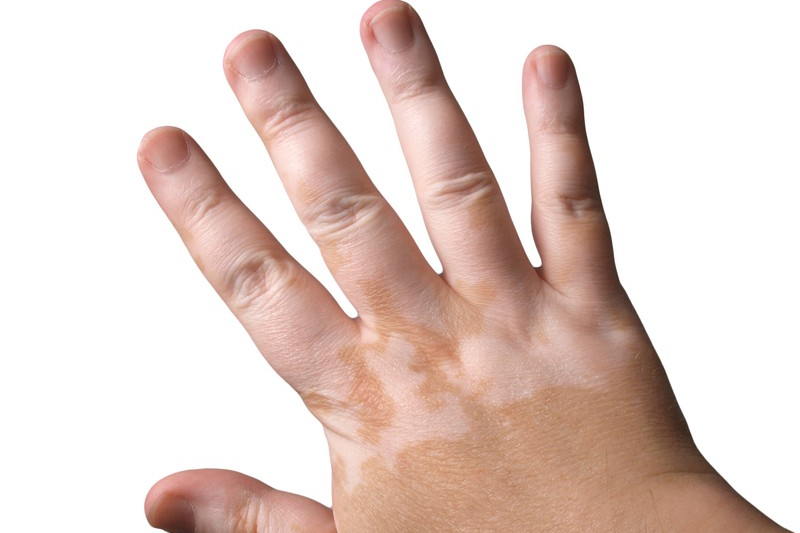About Vitiligo
Vitiligo is a skin disorder where areas of the skin lose their pigmentation, leaving well-demarcated white patches. The armpits, groin, face and hands are sites commonly affected. Vitiligo may also occur at sites of the skin where there has been injury or trauma, such as due to burns, cuts and lacerations. Most cases of vitiligo are diagnosed early in life, generally before the age of 20. However, the onset can occur at any age.
Cause
The cause of vitiligo is unknown. There are several theories surrounding the causes of vitiligo, including viruses, stress, autoimmunity (where the immune system attacks the body’s normal tissues) and chemicals. A link has been identified between vitiligo and some other autoimmune diseases, including pernicious anaemia, Hashimoto’s thyroiditis, type 1 diabetes and alopecia areata.
Melanocytes make melanin, a pigment which colours our skin, hair and eyes. These cells are stimulated to produce melanin by UV rays. Melanin protects the deeper layers of the skin from the effects of the sun and its rays. In people with vitiligo, for unknown reasons, the melanocytes in the skin die, causing a loss of pigmentation in the affected area of skin or hair.
Signs and Symptoms
 Other than the loss of colour over a patch or patches of skin or hair, there tends to be no other symptoms of vitiligo. Very occasionally sites may be mildly itchy. People with vitiligo may feel very self-conscious of their skin, which may lead to feelings of anxiety and depression.
Other than the loss of colour over a patch or patches of skin or hair, there tends to be no other symptoms of vitiligo. Very occasionally sites may be mildly itchy. People with vitiligo may feel very self-conscious of their skin, which may lead to feelings of anxiety and depression.
In the most common type of vitiligo, called non-segmental vitiligo, the patches of depigmentation are the same on both sides of the body – the pattern exhibits symmetry. The patches can initially be small and can gradually increase in size over time.
Segmental vitiligo is less common than non-segmental vitiligo. Segmental vitiligo tends to only affect an area of skin on one side of the body.
Treatment
Not all people with vitiligo undergo medical treatment. In some fair-skinned people, vitiligo may not be overtly obvious, especially if they try not to tan. Other people may have their vitiligo in an area that is easily covered by clothing. Others use make-up products that closely match the tone of their skin to cover up patches, and fake tanning products may also help to cover patches of vitiligo.
For others, medical treatment may be indicated. Some of the treatment options for vitiligo include:
- Creams: corticosteroids are the most efficacious in early stages of the disease. Corticosteroids are most commonly given as a topical cream, with the strength varying depending on the location of the depigmentation. For patches of vitiligo on the face, a lower dose of corticosteroid will be prescribed than for patches on the limbs. Other types of creams may also be trialled.
- Phototherapy: uses UV light rays to help return colour to the skin. The UV light helps to stimulate the melanocytes in the skin to produce melanin and return colour to the skin. The UV rays are administered via a lamp. Different doses are given depending on your normal skin colour. The treatment takes place in a special room, called a phototherapy room. It can take a number of months for the pigment to start to re-appear in the skin. There are some important side effects to note from phototherapy. Burning may result if the treatment is too long. There is also an increased risk of developing skin cancer following this treatment.
- Skin Grafts: skin grafts involve taking skin from one area of the body and placing it over a patch of skin that has been affected by vitiligo. This treatment will not be recommended if there are still patches of vitiligo developing on the body. It can also produce unsightly scarring in the area where the graft has been taken from.
- Depigmentation: this treatment is used for very widespread vitiligo where more than half of the skin has been affected. It involves using a treatment which removes the unaffected skin of its usual colour. It uses a very strong cream to achieve this, which can cause dermatitis in some patients. This process can take up to one year to complete. Following depigmentation therapy, patients need to be cautious about sun exposure and use appropriate sun protection measures (High SPF sunscreen, long sleeve clothing, hats and sunglasses). This is because the depigmented skin is much more vulnerable to sun damage.
Sometimes, a combination of the above therapies may be indicated for someone with vitiligo. Not one treatment works the same for each patient, and you may need to try different therapies before you find one that works for you. In some people, the patches may return after treatment.
Effects of Vitiligo
Vitiligo can adversely affect the mental health of its sufferers. You may feel embarrassed or self-conscious about your skin. People with vitiligo need to be vigilant about sun protection and sun exposure. De-pigmented areas of skin are much more likely to be damaged by the sun and there is an increased risk of developing skin cancer, especially if depigmentation therapy (see above) has been used as a treatment.
Vitiligo is a condition which requires specialist management. Dermatologists are highly experienced in managing vitiligo. If you have any questions or concerns about vitiligo make an appointment today. Contact us today.



